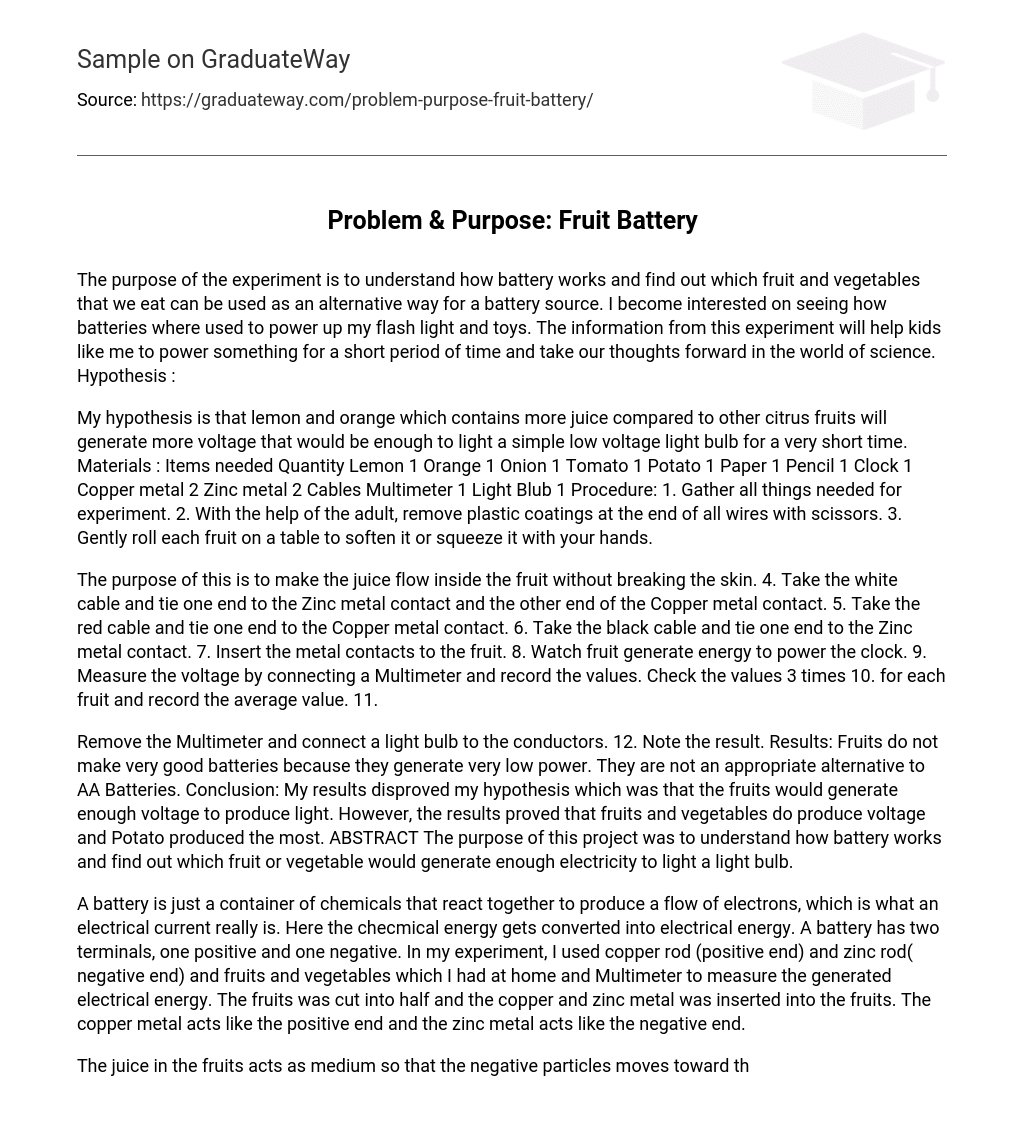The experiment aims to explore the function of batteries and examine which fruits and vegetables can be utilized as alternative sources of energy for batteries. I developed an interest in batteries when I observed their ability to power my flashlight and toys. The findings from this experiment will provide useful knowledge for children like me, enabling us to generate power for a limited duration and further our understanding in the field of science. Hypothesis:
The purpose of this experiment is to test the hypothesis that citrus fruits such as lemon and orange, which contain more juice than other citrus fruits, will produce a higher voltage capable of briefly lighting up a low voltage light bulb. The necessary materials for this experiment include: 1 lemon, 1 orange, 1 onion, 1 tomato, 1 potato, 1 sheet of paper, 1 pencil, 1 clock, 2 copper metal pieces, 2 zinc metal pieces, cables, 1 multimeter, and 1 light bulb.
To conduct the experiment:
- Gather all the required materials.
- Under adult supervision and using scissors remove the plastic coating from the ends of the wires.
- Soften each fruit by gently rolling it on a table or squeezing it with your hands.
The objective of this experiment is to allow juice to flow through a fruit without causing damage to its skin. To achieve this, follow the steps below:
4. Safely secure one end of the white cable to the Zinc metal contact and connect the other end to the Copper metal contact.
5. Use the red cable to connect one end with the Copper metal contact.
6. Likewise, attach one end of the black cable to the Zinc metal contact.
7. Insert both metal contacts into the fruit.
8. Watch as the fruit generates energy to power a clock.
9. Utilize a Multimeter device for measuring voltage and record these values. Repeat this process three times for each fruit and calculate an average value.
Remove the Multimeter and connect a light bulb to the conductors. 12. Note the result. Results: Fruits do not make very good batteries because they generate very low power. They are not an appropriate alternative to AA Batteries. Conclusion: My results disproved my hypothesis which was that the fruits would generate enough voltage to produce light. However, the results proved that fruits and vegetables do produce voltage and Potato produced the most.
ABSTRACT The purpose of this project was to understand how battery works and find out which fruit or vegetable would generate enough electricity to light a light bulb.
A battery functions as a vessel for chemicals that undergo reaction to produce an electron flow, which constitutes an electrical current. This conversion transforms chemical energy into electrical energy. Consisting of two terminals—one positive and one negative—a battery enables experimentation using various resources available at home, such as fruits and vegetables. In my own experiment, I employed copper rod as the positive end and zinc rod as the negative end, while utilizing a Multimeter to gauge the electrical energy generated. To execute the experiment, the fruits were halved and the copper and zinc metals were inserted into them. The copper metal serves as the positive end, while the zinc metal serves as the negative end.
The juice in the fruits serves as a medium for the movement of negative particles towards the positive end, resulting in a chemical reaction and the generation of voltage. I conducted an experiment by connecting a small digital clock to different metals and measuring the voltage produced by various fruits using a Multimeter. Next, I connected a light bulb to the metal ends. Contrary to my hypothesis, the results did not show sufficient voltage to produce light. Nevertheless, the results did confirm that fruits do generate voltage, although it is not enough to power a light bulb.





